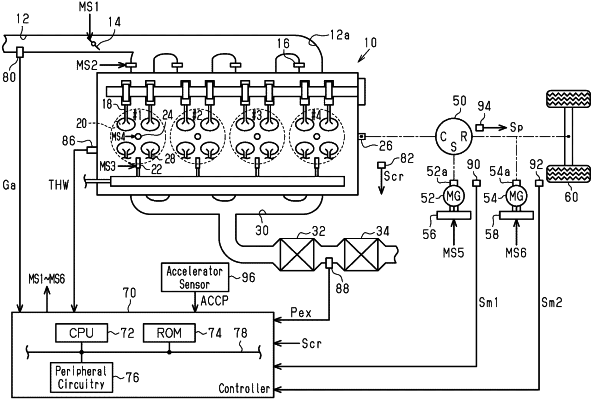| CPC B60W 20/15 (2016.01) [B60W 10/06 (2013.01); B60W 10/08 (2013.01); F02D 41/0087 (2013.01); B60W 2710/083 (2013.01)] | 6 Claims |

|
1. A controller for a hybrid electric vehicle, the controller being employed in the hybrid electric vehicle that includes an internal combustion engine, a first rotating electric machine, a second rotating electric machine, a driven wheel, and a power split device, wherein
the internal combustion engine and the first rotating electric machine are capable of applying power to the driven wheel via the power split device,
the second rotating electric machine is capable of applying power to the driven wheel without going through the power split device,
the internal combustion engine includes cylinders,
the controller is configured to execute:
a deactivating process that deactivates combustion control in a deactivated cylinder, the deactivated cylinder corresponding to one or more of the cylinders of the internal combustion engine;
a first compensation process that sets, when the deactivating process is executed, torque of the first rotating electric machine to be larger than torque of the first rotating electric machine obtained prior to starting the deactivating process so as to compensate for at least some of a decrease amount of torque of the internal combustion engine resulting from the deactivating process; and
a second compensation process that sets, when the deactivating process is executed, torque of the second rotating electric machine to be larger than torque of the second rotating electric machine obtained prior to starting the deactivating process so as to compensate for at least some of the decrease amount of the torque of the internal combustion engine resulting from the deactivating process,
a compression top dead center occurrence cycle indicates a cycle during which a compression top dead center occurs in the internal combustion engine,
the first compensation process cyclically fluctuates the torque of the first rotating electric machine in a cycle of an integral multiple of the compression top dead center occurrence cycle,
the second compensation process cyclically fluctuates the torque of the second rotating electric machine in a cycle of an integral multiple of the compression top dead center occurrence cycle,
the controller is configured to execute an energy increasing process that increases a combustion energy amount of a cylinder that differs from the deactivated cylinder of the internal combustion engine so as to compensate for the decrease in an output of the internal combustion engine resulting from the deactivating process,
the first compensation process includes a process that cyclically fluctuates, when the deactivating process is executed, an average value of an increase amount of an output of the first rotating electric machine resulting from the increase in the torque of the first rotating electric machine in a given time even after decreasing the average value to zero from a value greater than zero, and
the second compensation process includes a process that cyclically fluctuates, when the deactivating process is executed, an average value of an increase amount of an output of the second rotating electric machine resulting from the increase in the torque of the second rotating electric machine in the given time even after decreasing the average value to zero from a value greater than zero.
|